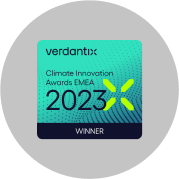“Start with baby steps. Don’t aim for perfection right away. Every small improvement is worth celebrating.”
– Antje Fuchs, Senior Product Manager, Sustainability, at Cority
As companies navigate growing regulations, shifting market expectations, and the challenge of managing data, having the right strategies and tools can make all the difference. Recently, Cority’s Sustainability Product Marketing Manager, Isha Varma, sat down with Antje Fuchs, Senior Product Manager Sustainability, to talk about her 13 years of background and experience in Finance and Sustainability. In this interview, Antje shares her views on the challenges and trends in sustainability management, the importance of data and technology, and how the right software solutions address these needs.
As Cority’s Senior Product Manager Sustainability, Antje’s key responsibilities center around shaping the product vision and defining product enhancement roadmaps for Cority’s Sustainability solutions. Prior to joining Cority, Antje spent close to a decade at Germany’s KfW Bankengruppe. First as a trainee, later as project manager and director of portfolio management, she was responsible for clients from all kinds of industries and all kinds of geographies. Antje holds a master’s degree in politics and economics.
Isha Varma (IV): Could you describe your current role at Cority? What do you usually do on a day-to-day basis?
Antje Fuchs (AF): When I’m asked about my role, I usually say that I’m a funnel. What I do is absorb all kinds of information from across the organization, about the product, what works, what doesn’t, market requirements, customer pain points, what resonates during a demo, and what doesn’t. It’s not so much about gathering statistics, it’s more about internalizing all that information.
Then, I mix it with our organizational strengths, what we’re good at, what we’ve been good at over the past four decades, and what the areas of improvement are. Out of that, I build a product strategy and set priorities for the next months and years. I also continue talking to other team members to validate whether I’ve captured everything correctly and if anything has changed since I first gathered that information. So, in essence, my role is like a communication funnel and a blender.
IV: Your role spans across functions, with a specific focus on our sustainability solutions. Can you walk us through your career journey? How did you end up in this product role and how did you specifically land in ESG and sustainability?
AF: When I first started working at KfW, during my training, I was looking for a job that would allow me to travel. I’ve always been passionate about traveling, so I wanted a job that offered travel opportunities. That’s how I ended up at KfW. Initially, it was the travel aspect that I loved, but my interest in sustainable finance developed later.
During my travels and in my role as a project manager, I worked on setting up projects for renewable energy infrastructure, sustainable finance, and financial instruments in Latin America. That’s when I realized how powerful money can be when it’s put in the right place, and how much harm it can do when it’s not. That’s what sparked my interest in sustainable finance.
Eventually, I left that job because I started a family and couldn’t travel as much. That’s when I found this role at Cority, which felt like the perfect continuation of my previous career.
Though I hadn’t used our software before, my experience in previous roles made the challenges that our customers face feel familiar, helping me quickly realize exactly what was needed to make day-to-day work easier.
I had all those discussions with IT departments about simplifying data collection and reporting, which they weren’t able to address. Now, I’m in a position where I can create the tools I wish I had back then. So, in a way, this role is the sequel to my previous career in finance.
IV: You have a fascinating background in investor finance and sustainability. Can you elaborate more on that intersection and what it entails?
AF: It’s a very complex area because there are so many conflicting targets within sustainability. Take renewable energy projects, for example. While the goal is to reduce carbon emissions, you often have to build infrastructure that impacts people’s livelihoods or ecosystems. There’s always a trade-off. In sustainable finance, organizations have to decide what trade-offs they’re willing to accept, and those decisions are very individual.
Every organization sets different focus areas and weighs priorities differently. What they all need, though, is robust data. They need to know what’s happening, what risks they’re taking, and whether their guardrails are working. That’s why robust sustainability management requires clean, reliable data. And every organization handles that data differently, which makes the space both challenging and never boring.
IV: Data seems to be a big factor in this. Do you see any other future trends shaping sustainability management for investors?
AF: Right now, we’re seeing some standardization and harmonization in how organizations set their focus areas and collect data. I hope this continues because it’s currently very difficult for organizations to make the right decisions about data collection. But I also think things will get more complex before they become more standardized. For example, while we’re very focused on carbon emissions right now, other areas like water stress, biodiversity, and social aspects are equally pressing. Measuring biodiversity, for instance, is much more complex than measuring carbon. So, we’ll see a lot of discussion and innovation in those areas.
AI is another big trend. We need to be cautious in how we apply it because robust decisions require clean data. Right now, AI models need a lot more training to get there, but I think we’ll see more robust AI tools that help clean up data and support decision-making in the coming years.
“Sustainability data is risk data. The better organizations are at ESG management, the more robust their business models are.”
– Antje Fuchs, Senior Product Manager, Sustainability, at Cority
IV: Let’s take a step back and talk about the role of technology in ESG and sustainability. What were some of the main challenges you faced in this space, both with and without technology?
AF: The biggest challenges were a lack of knowledge and a lack of acceptance of the complexity of sustainability. Sustainability touches on every aspect of human interaction with the planet and each other, so there’s a lot of data to collect. It’s time-consuming and stressful, and it takes a lot of effort to convince people to provide that data. You have to be very passionate or very convinced of its value.
From my perspective, sustainability data is risk data. The better organizations are at ESG management, the more robust their business models are. If a company started neglecting workers’ rights, for example, I could predict that they’d struggle financially within a year. Sustainability data isn’t just a nice-to-have; it’s essential for risk management. Not everyone realizes that.
IV: Risk seems to be a recurring theme. How has technology helped address some of these challenges?
AF: Technology is crucial for managing large amounts of data. I used to work with Excel and Word, and while it worked for smaller portfolios, it’s hard to maintain an overview with large datasets. Robust software tools help you sort data, identify gaps, and create forecasts. When choosing a software tool, you need to consider your requirements, pain points, and future needs. Will this tool still be useful five years from now? Technology helps you gather, organize, and make sense of data, which is essential for effective sustainability management.
IV: With the regulatory landscape changing and companies facing more pressure to develop strong sustainability strategies, what advice would you give to companies preparing for these shifts, especially with regulations like CSRD?
AF: The first step is to take a data inventory. What data are you already collecting? Can you improve it? Can you make it easier for people to provide that data? Once you have the data, can you centralize it and make connections between different datasets? For example, if one person knows how much water is available and another knows how much is needed for production, those two should be talking.
Start with baby steps. Don’t aim for perfection right away. Every small improvement is worth celebrating. Make sure you can convince people of the value of collecting that data, show management how it leads to better decisions, uncovers risks, or reveals opportunities. .
Selecting a scalable approach to sustainability data management ensures your solution grows alongside your organization, allowing you to track and report on ESG performance at every level, from facility to corporate, both now and in the future.
Take it one step at a time, and don’t try to do everything at once.
IV: That’s great advice. Given where the market is heading, what do you think will be the biggest innovations in sustainability reporting or management software?
AF: I think we’ll see consolidation in the market. Smaller tools with innovative functionalities may be absorbed by larger platforms. Integration will be key, sustainability software needs to fit into an organization’s broader software landscape and capture data from various areas. The focus will be on tools that not only produce outputs but also help clean up data and ensure high data quality. AI will continue to grow, but it needs to be applied carefully to ensure robust decision-making.
“EHS is a critical part of sustainability management. The data in EHS is very granular and integrating it with sustainability solutions helps organizations make robust, holistic decisions.”
– Antje Fuchs, Senior Product Manager, Sustainability, at Cority
IV: Finally, with all these trends in mind, what are your key areas of focus for product development and strategy at Cority over the next year or two?
AF: We’ll continue to polish our analytics and output capabilities, helping users create meaningful insights from their data. But a big focus will be on integrating our sustainability solutions with other Cority products. Sustainability data is interconnected with data from other areas, so we want to ensure users can leverage all the data within our ecosystem. Additionally, as sustainability teams grow and involve more departments, user experience will be a priority. We need to make the tools as easy and comfortable to use as possible, even for people who don’t focus solely on sustainability. Accessibility, including translations and global usability, will also be important.
IV: You mentioned integrating sustainability data with other systems. At Cority, we offer unified EHS and ESG solutions. What are your thoughts on the importance of bringing these two worlds together?
AF: EHS is a critical part of sustainability management. The data in EHS is very granular, environmental data can be collected every second, and safety data is gathered daily. This high-frequency data is incredibly valuable, but for high-level decisions, it needs to be aggregated and connected with other data points. At Cority, we can collect that granular data in our EHS solutions and then integrate it into our sustainability solutions, where it’s aggregated and analyzed alongside data from other areas. This helps organizations make robust, holistic decisions that consider all aspects of their operations.
Ready to see how Cority can help your business advance its sustainability data management and reporting? Check out our Sustainability Cloud or request a demo today to see our award-winning software solutions.











